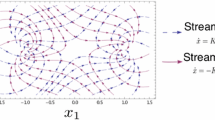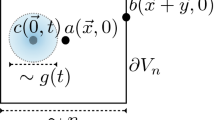Abstract
We derive hydrodynamic equations for systems not in local thermodynamic equilibrium, that is, where the local stationary measures are “non-Gibbsian” and do not satisfy detailed balance with respect to the microscopic dynamics. As a main example we consider thedriven diffusive systems (DDS), such as electrical conductors in an applied field with diffusion of charge carriers. In such systems, the hydrodynamic description is provided by a nonlinear drift-diffusion equation, which we derive by a microscopic method ofnonequilibrium distributions. The formal derivation yields a Green-Kubo formula for the bulk diffusion matrix and microscopic prescriptions for the drift velocity and “nonequilibrium entropy” as functions of charge density. Properties of the hydrodynamic equations are established, including an “H-theorem” on increase of the thermodynamic potential, or “entropy”, describing approach to the homogeneous steady state. The results are shown to be consistent with the derivation of the linearized hydrodynamics for DDS by the Kadanoff-Martin correlation-function method and with rigorous results for particular models. We discuss also the internal noise in such systems, which we show to be governed by a generalizedfluctuation-dissipation relation (FDR), whose validity is not restricted to thermal equilibrium or to time-reversible systems. In the case of DDS, the FDR yields a version of a relation proposed some time ago by Price between the covariance matrix of electrical current noise and the bulk diffusion matrix of charge density. Our derivation of the hydrodynamic laws is in a form—the so-called “Onsager force-flux form” which allows us to exploit the FDR to construct the Langevin description of the fluctuations. In particular, we show that the probability of large fluctuations in the hydrodynamic histories is governed by a version of the Onsager “principle of least dissipation,” which estimates the probability of fluctuations in terms of the Ohmic dissipation required to produce them and provides a variational characterization of the most probable behavior as that associated to least (excess) dissipation. Finally, we consider the relation of longrange spatial correlations in the steady state of the DDS and the validity of ordinary hydrodynamic laws. We also discuss briefly the application of the general methods of this paper to other cases, such as reaction-diffusion systems or magnetohydrodynamics of plasmas.
Similar content being viewed by others
References
H. Mori,Phys. Rev. 111:694 (1958);112:1829 (1958).
D. N. Zubarev,Nonequilibrium statistical Thermodynamics (Consultants Bureau, New York, 1974).
J. A. McLennan,Introduction to Nonequilibrium Statistical Mechanics (Prentice-Hall, Englewood Cliffs, New Jersey, 1989).
Y. G. Sinai,Selecta Math. Sov. 7:279 (1988).
G. Eyink, Nonequilibrium statistical distributions, unpublished.
G. L. Eyink, J. L. Lebowitz, and H. Spohn, Microscopic origin of hydrodynamic behavior: Entropy production and the steady-state, inChaos/Xaoc, Soviet-American Perspectives on Nonlinear Science, D. K. Campbell, ed. (American Institute of Physics, New York, 1990).
D. N. Zubarev and V. G. Morozov,Physica A 120:411 (1983).
R. Zwanzig,J. Chem. Phys. 33:1338 (1960).
A. Einstein,Ann. Phys. (Leipzig)22:180 (1907);33: 1275 (1910).
L. Onsager,Phys. Rev. 37:405 (1931);38:2265 (1931).
G. H. Wannier,Phys. Rev. 83:281 (1951);87:795 (1952).
G. H. Wannier,Bell. Syst. Techn. J. 32:170 (1953).
P. A. Markowich, C. A. Ringhofer, and C. Schmeisser,Semiconductor Equations (Springer, Vienna, 1990).
S. Katz, J. L. Lebowitz, and H. Spohn,J. Stat. Phys. 34:497 (1984).
B. Schmittmann and R. K. P. Zia, Statistical mechanics of driven diffusive systems, inPhase Transitions and Critical Phenomena, C. Domb and J. L. Lebowitz, eds. (Academic Press, London, 1995).
R. Esposito, R. Marra, and H. T. Yau, Diffusive limit of asymmetric simple exclusion, inThe State of Matter, M. Aizenmann and H. Araki, eds (World Scientific, Singapore, 1994).
C. Landim, S. Olla, and H.-T. Yau, First-order correction for the hydrodynamic limit of asymmetric simple exclusion processes in dimensiond≥3, Preprint, Ecole Polytechnique, R.I. No. 307 (Novemeber 1994).
V. P. Kalashnikov,Phys. Lett. A 26:433 (1968).
N. I. Chernov, G. L. Eyink, J. L. Lebowitz, and Y. G. Sinai,Commun. Math. Phys. 154:569 (1993).
H. Spohn,Large Scale Dynamics of Interacting Particles (Springer-Verlag, New York, 1991).
P. J. Price, InFluctuation Phenomena in Solids, R. E. Burgess, ed. (Academic Press, New York, 1965), p. 355.
L. P. Kadanoff and P. C. Martin,Ann. Phys. (N.Y.) 24:419 (1963).
D. Forster,Hydrodynamic Fluctuations, Broken Symmetry, and Correlation Functions (Benjamin, Reading, Massachusetts, 1975).
R. Graham,Z. Phys. B 26:397 (1977).
R. Graham,Z. Phys. B 26:281 (1977).
H.-O. Georgii,Gibbs Measures and Phase Transitions (de Gruyter, Berlin, 1988).
L. D. Landau and E. M. Lifshitz,Electrodynamics of Continuous Media (Pergamon, London, 1960).
S. R. de Groot and P. Mazur,Nonequilibrium Thermodynamics (North-Holland, Amsterdam, 1962).
H. B. Callen,Thermodynamics (Wiley, New York, 1960).
P. L. Garrido, J. L. Lebowitz, C. Maes, and H. Spohn,Phys. Rev. A 42: 1954 (1990).
J. L. Lebowitz and R. H. Schonmann,Prob. Theory Related Fields 77:49 (1988).
R. S. Ellis,Entropy, Large Deviations, and Statistical Mechanics (Springer, New York, 1985).
H. Künsch,Z. Wahrsch. Geb. 66:407 (1984).
G. L. Eyink, Entropy, statistical mechanics, and PDE's, unpublished.
H. van Beijeren,J. Stat. Phys. 35:399 (1984).
L. Onsager and S. Machlup,Phys. Rev. 91:1505 (1953).
G. L. Eyink,J. Stat. Phys. 61:533 (1990).
H. Haken,Synergetics (Springer-Verlag, Berlin, 1978).
J. W. Dufty and J. M. Rubi,Phys. Rev. A 36:222 (1987).
J. A. Krommes and G. Hu,Phys. Fluids B 5:3908 (1993).
L. D. Landau and E. M. Lifshitz,Fluid Mechanics (Pergamon Press, London, 1959).
R. Stratonovich,Nonlinear Nonequilibrium Thermodynamics I (Springer, Berlin, 1992).
A. Einstein,Ann. Phys. (Leipzig)17:549 (1905).
B. Callen and T. A. Welton,Phys. Rev.,83:34 (1951).
H. Nyquist,Phys. Rev. 32:110 (1928).
R. F. Fox and G. E. Uhlenbeck,Phys. Fluids 13:1893 (1970).
K. Tomita and H. Tomita,Prog. Theor. Phys. 51:1731 (1974).
S. V. Gantsevich, V. L. Gurevich, and R. Katillius,Nuovo Cimento 2:1 (1979).
A.-M. S. Tremblay, InRecent Developments in Nonequilibrium Thermodynamics (Springer, Berlin, 1984).
C. Landim, S. Olla, and H. T. Yau, Some properties of the diffusion coefficient for asymmetric simple exclusion process, Ecole Polytechnique, R.I. No. 327 (June 1995).
M. Q. Zhang, J. S. Wang, J. L. Lebowitz, and J. L. Valles,J. Stat. Phys. 52: 1461 (1988).
R. K. P. Zia and B. Schmittmann, On singularities in the disordered phase of a driven diffusive system, preprint (1995).
A. Aharony,Phys. Rev. B 8:3363 (1973).
J. Skalyo, B. C. Frazer, and Shirane,Phys. Rev. B 1:278 (1970).
E. R. Speer, The two species, totally asymmetric simple exclusion process, inOn Three Levels, M. Fannes, C. Maes, and A. Verbeure, eds. (Plenum Press, New York, 1994). p. 91.
B. Derrida, S. Janowsky, J. L. Lebowitz, and E. Speer,Europhys. Lett. 22: 651 (1993);J. Stat. Phys. 73:813 (1993).
B. M. Law, R. W. Gammon, and J. V. Sengers,Phys. Rev. Lett. 60:1554 (1988).
V. G. Morozov,Physica A 126:461 (1984).
R. Graham and H. Haken,Z. Phys. 243:289 (1971);245: 141 (1971).
D. Gabrielli, G. Jona-Lasinio, and C. Landim, Onsager reciprocity relations without microscopic reversibility, preprint [mp_arc@ftp.ma.utexas.edu, #95-366].
C. Kipnis, S. Olla, and S. R. S. Varadhan,Commun. Pure Appl. Math. XLII:243 (1989).
R. Graham, InOrder and Fluctuations in Equilibrium and Nonequilibrium Statistical Mechanics, G. Nicolis, G. Dewel, and J. W. Turner, eds. (Wiley, New York, 1981).
R. Graham, InStochastic Processes in Nonequilibrium Systems, L. Garrido, P. Seglar, and P. J. Shephard, eds. (Springer, Berlin, 1978).
M. I. Freidlin and A. D. Wentzell,Random Perturbations of Dynamical Systems (Springer, New York, 1984).
D. A. Dawson and J. GärtnerStochastics 20:247 (1987).
Y. Oono,Prog. Theor. Phys. Suppl. 99:165 (1989).
E. B. Pitman and D. G. Schaeffer,Commun. Pure Appl. Math. 40:421 (1987).
A. De Masi, E. Presutti, and J. L. Lebowitz,J. Stat. Phys. 55:523 (1986).
G. Jona-Lasinio, C. Landim, and M. E. Vares,Prob. Theory Related Fields 97:339 (1993).
G. Jona-Lasinio,Ann. Inst. H. Poincaré 55(2):751 (1991).
R. Balescu,Transport Process in Plasmas (North-Holland, Amsterdam, 1988).
R. Balescu,Phys. Fluids B 3:564 (1991).
A. van Enter, R. Fernández, and A. Sokel,J. Stat. Phys. 72:879 (1993).
T. J. Liggett,Interacting Particle Systems (Springer, Berlin, 1985).
F. Rezakhanlou,Commun. Math. Phys. 140:417 (1991).
H. van Beijeren, R. Kutner, and H. Spohn,Phys. Rev. Lett. 54:2026 (1985).
J. Krug and H. Spohn, Kinetic roughening of growing surfaces inSolids Far From Equilibrium: Growth, Morphology and Defects, C. Godréche, ed. (Cambridge University Press, Cambridge, 1991).
Lin Xu, Diffusion limit for lattice gas with short-range interactions, Thesis, NYU (1993).
H. O. Georgii,Canonical Gibbs Measures (Springer-Verlag, Berlin, 1979).
R. H. Kraichnan,Phys. Rev. 113:1181 (1959).
G. Gallavotti and E. Verboven,Nuovo Cimento 28:274 (1975).
M. Aizenman et al.,Commun. Math. Phys. 53:209 (1977).
M. Aizenman et al.,Commun. Math. Phys. 48:1 (1976).
Author information
Authors and Affiliations
Rights and permissions
About this article
Cite this article
Eyink, G.L., Lebowitz, J.L. & Spohn, H. Hydrodynamics and fluctuations outside of local equilibrium: Driven diffusive systems. J Stat Phys 83, 385–472 (1996). https://doi.org/10.1007/BF02183738
Received:
Accepted:
Issue Date:
DOI: https://doi.org/10.1007/BF02183738




